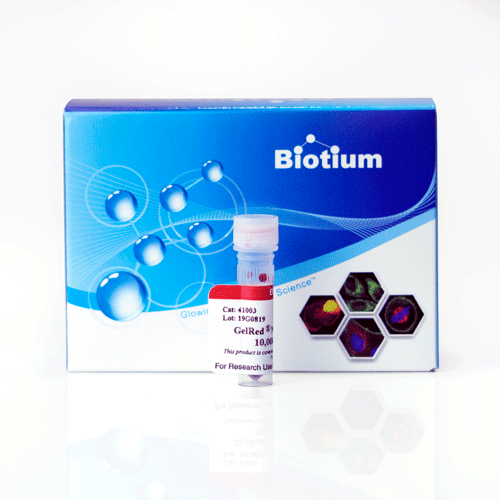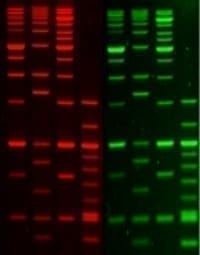PAGE GelRed® Nucleic Acid Gel Stain
PAGE GelRed® is a non-toxic, non-mutagenic red DNA gel stain specifically formulated to stain DNA in polyacrylamide gels. PAGE GelRed® can be imaged using a 254 nm UV transilluminator with an ethidium bromide filter.
Please fill in the inquiry form and we will contact you shortly.
Wishlist updated! View wishlist
Product Description
PAGE GelRed® is an ultra sensitive, extremely stable, and environmentally safe fluorescent nucleic acid dye specifically designed to stain DNA in polyacrylamide gels.
- Superior dsDNA staining in polyacrylamide gels
- Formulated for efficient penetration of polyacrylamide gel
- Safer than EtBr: non-mutagenic and non-hazardous for disposal
- Simple pre- and post-electrophoresis gel staining, no destaining
- Use with standard EtBr imaging equipment or optical settings
- Compatible with downstream gel purification, restriction digest, sequencing, and cloning
PAGE GelRed® is a non-toxic, non-mutagenic red DNA gel stain specifically designed to stain DNA in polyacrylamide gels. It can be imaged using a 254 nm UV transilluminator with an ethidium bromide filter and can be removed from DNA gel staining using commonly available gel extraction kits. PAGE GelRed® is 6-8 times more sensitive for dsDNA over RNA. PAGE GelRed® is offered at 10,000X and 1X concentrations. Only the highly concentrated, 10,000X in water, can be used for pre-casting. While both concentrations of PAGE GelRed® can be used as a post-electrophoresis gel stain, 1x PAGE GelRed® is supplied in a 4L Cubitainer® as a convenient and easily dispensed, ready-to-use post-stain.
PAGE GelRed®: A Superior Dye for Polyacrylamide Gels
The original GelRed® and GelGreen® dyes, the dyes’ membrane impermeability was achieved by mainly making the dyes physically large. While this strategy works extremely well to improve the dyes’ safety, the relatively large size of GelRed® and GelGreen® make the dyes difficult to penetrate into the more densely packed polyacrylamide gels, rendering the dyes less optimal for PAGE gel staining.
In designing PAGE GelRed®, we used a novel approach to make the dye membrane impermeable without making the dye large. As a result, PAGE GelRed readily stains dsDNA in densely packed polyacrylamide gels. Importantly, the dye still possesses the benefits that the Original GelRed® is known for; safety, sensitivity, stability, and compatibility with existing instruments and downstream sample analysis. Also see our GelRed® and GelGreen® Frequently Asked Questions (FAQs).
Non-Mutagenic and Safer for the Environment
A series of safety tests have confirmed that PAGE GelRed® is non-cytotoxic, non-mutagenic, and non-hazardous at concentrations well above the working concentrations used in gel staining. As a result, working strength PAGE GelRed® can be safely disposed of down the drain or in regular trash, providing convenience and reducing cost in waste disposal. For detailed test results, you may download the PAGE GelRed® Safety Report.
How Safe is Your Gel Stain?
Many so-called “safe” DNA dyes like SYBR® Safe, Midori Green, GreenSafe, SafeView™, and RedSafe™ not only have low sensitivity, but also readily penetrate living cells to bind DNA, and some are cytotoxic. Unlike these dyes, GelRed® is cell membrane-impermeant, so it cannot enter living cells to interact with their DNA. See our Gel Stains Comparison Flyer or Gel Stains Comparison White Paper for details.
Choose the Right Stain for Your Application
PAGE GelRed® Nucleic Acid Gel Stain is the recommended stain for staining DNA in polyacrylamide gels. While PAGE GelRed® can be used to stain DNA in agarose gels but will be less sensitive than Original GelRed®. For pre-cast gel staining, only the highly concentrated dye solution, 10,000X in water, can be used by adding the dye directly to molten agarose. While both concentrations of PAGE GelRed® can be used as a post-electrophoresis gel stain, 1X PAGE GelRed® is supplied in a 4L Cubitainer® as a convenient and easily dispensed, ready-to-use post-stain.
For agarose gels, we recommend using Original GelRed® Nucleic Acid Gel Stain or GelGreen® Nucleic Acid Gel Stain. While PAGE GelRed® can be used to stain DNA in agarose gels, it will be less sensitive than the Original GelRed®. GelRed® 3X in water is ready-to-use for post-electrophoresis gel staining, and is supplied in a 4L Cubitainer®. Higher concentrations of Original GelRed® are available as 10,000X in water or DMSO. GelRed® in water is a newer, safer formulation and our recommended format. We continue to offer GelRed® in DMSO for established users who do not wish to alter their protocols. We also offer GelRed® Agarose and GelRed® Prestain Plus 6X Loading Dye. GelGreen® Nucleic Acid Gel Stain, a safer replacement for SYBR® gel stains, which is compatible with visible light excitation. For more information, view our DNA Gel Stains Technology Page.
| Product / Method | Procedure | Advantages | Disadvantages | Recommended for |
|---|---|---|---|---|
| DNA staining with EMBER™ Ultra DNA Gel Kit | Agarose is supplied pre-coated with EMBER™ Ultra Dye, just dissolve, heat, and pour. | • Safer and more convenient, no need to handle concentrated dye • Superior sensitivity, detect as little as ≤1 ng DNA • No need for post-electrophoresis staining • Optimal for blue LED gel imagers | • Not suitable for PAGE, DGGE, EMSA, or PFGE gels • Dye may cause band migration issues when loading larger amounts of DNA (more than ~200 ng/band), or for some restriction digests | • Routine agarose gels |
| RNA staining with EMBER™ Ultra RNA Gel Kit | Agarose is supplied pre-coated with EMBER™ Ultra Dye, just dissolve, heat, and pour. | • Safer and more convenient stain for RNA, no need to handle concentrated dye • Superior sensitivity, detect as little as ≤5 ng RNA • No need for post-electrophoresis staining • Included loading dye contains formamide for denaturing • Optimal for blue LED gel imagers | • Will stain DNA as well as RNA • Dye may cause band migration issues when loading larger amounts of RNA (more than ~200 ng/band) | • Routine RNA gel electrophoresis • Evaluate total RNA integrity and DNA contamination |
| DNA prestaining with GelRed® Prestain Plus 6X DNA Loading Dye | GelRed® loading buffer is added directly to the DNA sample before loading | • Fast & simple: one-step sample loading & DNA staining • Less concentrated dye for safer handling • Can re-run a gel to use empty lanes | • Not recommended for PAGE, DGGE, EMSA, or PFGE gels • Dye may cause band migration issues when loading larger amounts of DNA (more than ~100 ng/band), or for some restriction digests | • Routine agarose gels • Recommended loading 50-200 ng ladder or 2-5 uL PCR product ( ~100 ng/band or less) |
| Precast staining with GelRed® 10,000X in water or GelGreen® 10,000X in water | GelRed® or GelGreen® is mixed with molten agarose before gel casting | Familiar protocol, rapid results | ||
| Precast staining with GelRed® Agarose LE or GelGreen® Agarose LE | Agarose is supplied pre-coated with GelRed® or GelGreen®, just dissolve, heat, and pour | Safer & more convenient, no need to handle concentrated dye | ||
| Post-electrophoresis staining with GelRed® 10,000X in water or GelGreen® 10,000X in water - or - GelRed® 3X in water | No fluorescent dye is added to the gel, it is stained in 3X GelRed® or 3X GelGreen® solution after electrophoresis | • Most accurate sizing/sharpest bands • Staining solution can be re-used • Enhance sensitivity by adding NaCl | Extra staining step (up to 30 minutes) after electrophoresis (some customers report good results after only 5 minutes if dye is not reused) | • Highly accurate band sizing • Gels with more than ~100 ng DNA per band • Analyzing restriction digests |
| Post-electrophoresis staining of PAGE gels using PAGE GelRed® 10,000X or 1X in water | No fluorescent dye is added to the gel, it is stained in 1X PAGE GelRed® solution after electrophoresis | • Formulated for efficient penetration and staining of polyacrylamide gels • Like the classic GelRed®, it is safe and environmentally friendly | Extra staining step of approx. 30 minutes after electrophoresis | Staining of nucleic acids in PAGE gels |
References
Download a list of curated references for GelRed® and GelGreen®.


